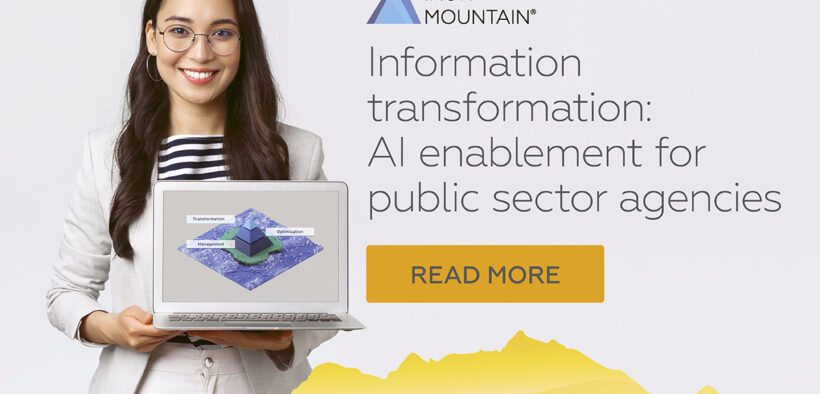Information and data are the foundations of modern organisations, but many have only a limited understanding of their information assets and how they can be used.
Information can be spread across different locations and media types (physical and digital), stored in different formats, and be inaccurate or out-dated. Many organisations lack a standardised method for access and retrieval, and even when physical information is digitised, that does not translate into understanding, unifying, and making that information accessible, causing productivity issues for workers.
In short, these factors conspire to ensure the organisation is not getting full value from its data assets and is also likely missing out on opportunities to save on costs and improve overall efficiencies.
These issues are commonplace within public sector departments and agencies, whose information repositories may contain centuries-old information. Not only does this make it difficult for them to create information services that meet the expectations of today’s citizens, but it also hamstrings efforts to embrace newer technologies such as automated workflows and artificial intelligence.
What is needed is a comprehensive approach to managing information across physical and digital media, one backed by the skills required to classify, organise, secure, digitise, access, and automate information in a clearly defined and logical manner.
At Iron Mountain, we call this process information transformation. It starts by having the agency assess its current information capabilities and potential gaps using a three-stage transformation maturity model.
A roadmap for information transformation
The first stage, business-critical information management, identifies the agency’s different information types and management structures to reduce risk and maintain compliance, and then begins digitising, finding, and organising information. The goal of this stage is to improve decision-making by unlocking insights and identifying patterns in the data.
The second stage, business information optimisation, finds efficiencies and savings through the creation of information workflows to improve worker productivity, while the third stage, business information transformation, introduces process and workflow automation to improve efficiencies. This is where you can also use your trusted data to identify patterns in the information and accelerate the application of insights.
This three-stage approach enables public sector agencies to develop a plan that can be used to map out the workflows that will put information to work for both staff and citizens. This can happen through streamlining information retrieval and decision-making processes and through the creation of automated citizen-facing applications and services.
By developing an information transformation plan, agencies can begin improving decision-making and tackle the bottlenecks within their information flows. This can be critical to meeting specific goals, such as the need to process Freedom of Information requests in a timely manner.
An information transformation plan also creates the ideal foundation for the introduction of artificial intelligence into systems and processes by enabling the development of guardrails and other governance tools that can ensure that data is used appropriately and is properly protected. This can be critical for ensuring that the insights generated through the AI programme can be implemented quickly with minimal disruption. Business information transformation takes this one step further by automating those workflows.
Furthermore, it introduces commonalities into data processes across departments, which can streamline the creation of cross-departmental information projects. By ensuring that a department or agency has a complete understanding of the information in its possession, it is placed in a strong position to understand how those information assets might interoperate with those from other agencies to create new services for citizens, including how it might navigate relevant regulatory or legislative requirements.
Putting information to work
Ultimately, information transformation also enables agencies to develop entirely new services based around their information assets, which can even lead to the creation of new revenue streams.
For example, at the United Kingdom Probate Service, Iron Mountain helped that agency with the task of preserving and digitising the records of 41 million British citizens, including those relating to famous and noteworthy individuals, some of which were stored on physical media that was centuries old.
Iron Mountain also enabled the introduction of automated workflows, which have enabled the Probate Service to introduce a new service whereby citizens can pay to access records through an e-commerce portal. This has created a new revenue source for the UK government that is fully compliant with all legislative requirements for data protection.
Planning for success through information management
For more than 70 years, Iron Mountain has been helping government agencies around the world better manage their information assets. This heritage means Iron Mountain has the experience needed to assist with all aspects of information transformation, from the preservation, management, and destruction of physical media through to the digitisation and automation of digital assets.
We might live in a digital world, but it is still run by humans, for humans.
Iron Mountain brings the human oversight and cutting-edge tools that are essential for delivering next-generation information services that meet today’s requirements for security and governance.
To learn more and assess your information maturity, download the full paper.
Download now >
Paul Lamb
Paul has over 30 years of IT industry experience in executive roles across commercial departments, business units, technology architecture and design, and consulting functions. He has a strong architecture background in multiple IT disciplines including software development, information management, and IT operations, with proven ability to build strategy and to drive business value through technology.

























































